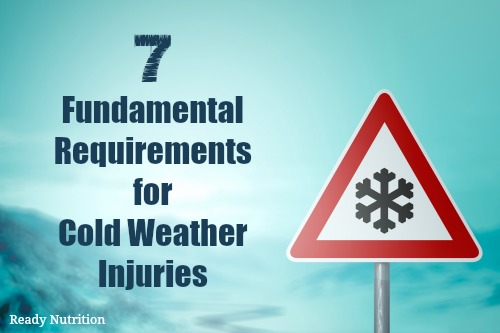
Hypothermia (injury by heat loss) is one of the most obvious drawbacks in the winter, but there is one that should bear mention before it: dehydration. Yes, something you would normally associate with the summer months also comes to bear in the winter. Why? It is because people drink less water in a cold weather environment. In addition to this, your body requires a larger volume of water than normal due to the calories spent in physical activity and the amount of stress your body suffers to keep it warm.
Your key indicator is thirst, and this is a late sign of dehydration. When you are thirsty, your body has gone beyond the point where it needed water. Such is why you must have canteens that can deliver, and just as important: you must use them. If normal requirements are a gallon a day per person, you need roughly 25% more, or 1 gallon + 1 quart to maintain yourself in a cold weather/winter environment.
Another sign of dehydration is the color of your urine. The darker the color, the more dehydrated you are. Now, there is another phase that you need to be aware of with the human body, and that phase is indicated by urine that is dark, the color of pancake syrup. This condition is called acute myoglobinuria, and it is an indicator that you are in serious trouble and about to go into renal failure. Usually this condition arises as a result of trauma, especially burns, however, it can also be from severe dehydration.
Here is a list of several injuries and problems encountered in a cold weather/winter environment that we will be covering individually and in detail:
- Frostbite
- All stages of hypothermia
- Snow glare and snow blindness
- Life threatening storms
- Immersion foot
- Vitamin deficiencies (long-term situations)
- Stranded/transportation break down
- Lack of food and water
The list is not comprehensive; however, these cover many of the situations you will find yourself in when in the wilderness. Here are the first aid basics to follow when in a survival situation in the wilderness during the winter:
- Always treat for shock: As we mentioned in the previously-posted article, shock is the killer and must be treated as one that can strike insidiously over time or suddenly without warning.
- ABC’s: Airway, Breathing, and Circulation. Ensure the patient has a clear, unobstructed airway, and that he or she is breathing. Next check for a pulse and if one is not found, immediately initiate CPR procedures. The “C” also means check for circulation with regard to bleeding.
- Stop-Gap: stop the major bleeds or fluid losses immediately
- Keep the patient warm, alert, and as comfortable as possible
- Shelter: for both you and your patient; this must be found prior to nightfall, and includes preparations for a fire, as the nighttime temperature will decrease significantly. Gather enough wood as will be needed and remember you must keep the supply continuous.
- Signal: either by cell phone, radio, or visual signaling device if you and your patient are unable to leave the immediate vicinity where the injury has occurred.
- Security: from all things – animals, people, weather; you must protect yourself and your patient at all times and do not allow further harm to come to him or her. You must constantly be on the alert for threats that also take the form of changing and worsening conditions that could hurt the both of you.
These are your basic parameters to follow for cold weather injuries. We will be covering the list (as well as other scenarios) and utilizing the skills necessary for each different problem encountered. Remember to prepare beforehand: know the area you are going to be in. Where are the nearest Ranger stations? Where is the nearest hospital? It may be the difference between life and death to know how to raise one of these on a Ham radio station. Knowing the way to get out of an area is just as important as knowing how to go in.
JJ
